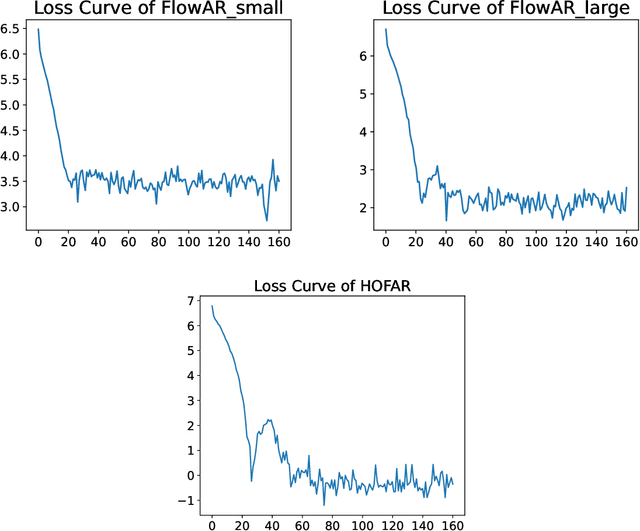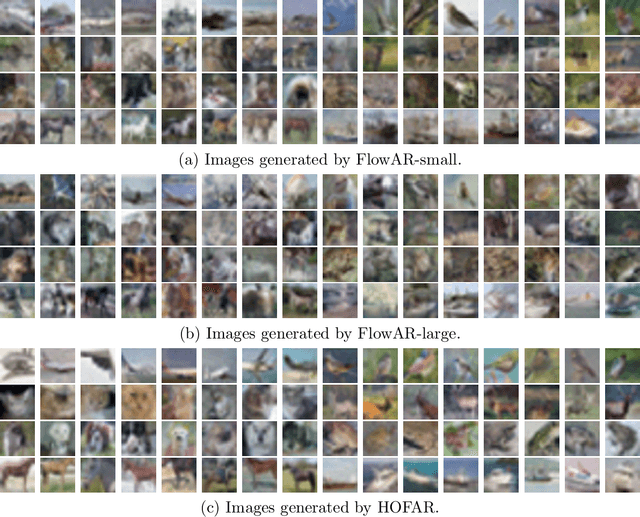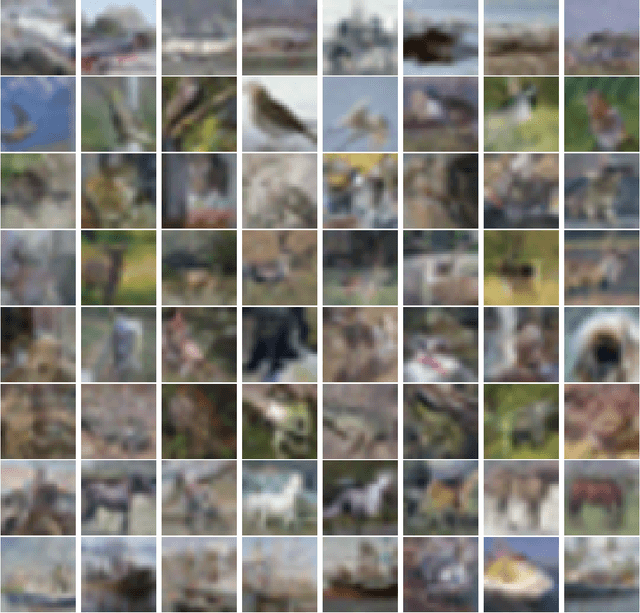Zhizhou Sha
The Path Not Taken: RLVR Provably Learns Off the Principals
Nov 11, 2025Abstract:Reinforcement Learning with Verifiable Rewards (RLVR) reliably improves the reasoning performance of large language models, yet it appears to modify only a small fraction of parameters. We revisit this paradox and show that sparsity is a surface artifact of a model-conditioned optimization bias: for a fixed pretrained model, updates consistently localize to preferred parameter regions, highly consistent across runs and largely invariant to datasets and RL recipes. We mechanistically explain these dynamics with a Three-Gate Theory: Gate I (KL Anchor) imposes a KL-constrained update; Gate II (Model Geometry) steers the step off principal directions into low-curvature, spectrum-preserving subspaces; and Gate III (Precision) hides micro-updates in non-preferred regions, making the off-principal bias appear as sparsity. We then validate this theory and, for the first time, provide a parameter-level characterization of RLVR's learning dynamics: RLVR learns off principal directions in weight space, achieving gains via minimal spectral drift, reduced principal-subspace rotation, and off-principal update alignment. In contrast, SFT targets principal weights, distorts the spectrum, and even lags RLVR. Together, these results provide the first parameter-space account of RLVR's training dynamics, revealing clear regularities in how parameters evolve. Crucially, we show that RL operates in a distinct optimization regime from SFT, so directly adapting SFT-era parameter-efficient fine-tuning (PEFT) methods can be flawed, as evidenced by our case studies on advanced sparse fine-tuning and LoRA variants. We hope this work charts a path toward a white-box understanding of RLVR and the design of geometry-aware, RLVR-native learning algorithms, rather than repurposed SFT-era heuristics.
Discriminator-Free Direct Preference Optimization for Video Diffusion
Apr 11, 2025Abstract:Direct Preference Optimization (DPO), which aligns models with human preferences through win/lose data pairs, has achieved remarkable success in language and image generation. However, applying DPO to video diffusion models faces critical challenges: (1) Data inefficiency. Generating thousands of videos per DPO iteration incurs prohibitive costs; (2) Evaluation uncertainty. Human annotations suffer from subjective bias, and automated discriminators fail to detect subtle temporal artifacts like flickering or motion incoherence. To address these, we propose a discriminator-free video DPO framework that: (1) Uses original real videos as win cases and their edited versions (e.g., reversed, shuffled, or noise-corrupted clips) as lose cases; (2) Trains video diffusion models to distinguish and avoid artifacts introduced by editing. This approach eliminates the need for costly synthetic video comparisons, provides unambiguous quality signals, and enables unlimited training data expansion through simple editing operations. We theoretically prove the framework's effectiveness even when real videos and model-generated videos follow different distributions. Experiments on CogVideoX demonstrate the efficiency of the proposed method.
HOFAR: High-Order Augmentation of Flow Autoregressive Transformers
Mar 11, 2025



Abstract:Flow Matching and Transformer architectures have demonstrated remarkable performance in image generation tasks, with recent work FlowAR [Ren et al., 2024] synergistically integrating both paradigms to advance synthesis fidelity. However, current FlowAR implementations remain constrained by first-order trajectory modeling during the generation process. This paper introduces a novel framework that systematically enhances flow autoregressive transformers through high-order supervision. We provide theoretical analysis and empirical evaluation showing that our High-Order FlowAR (HOFAR) demonstrates measurable improvements in generation quality compared to baseline models. The proposed approach advances the understanding of flow-based autoregressive modeling by introducing a systematic framework for analyzing trajectory dynamics through high-order expansion.
On Computational Limits of FlowAR Models: Expressivity and Efficiency
Feb 23, 2025Abstract:The expressive power and computational complexity of deep visual generative models, such as flow-based and autoregressive (AR) models, have gained considerable interest for their wide-ranging applications in generative tasks. However, the theoretical characterization of their expressiveness through the lens of circuit complexity remains underexplored, particularly for the state-of-the-art architecture like FlowAR proposed by [Ren et al., 2024], which integrates flow-based and autoregressive mechanisms. This gap limits our understanding of their inherent computational limits and practical efficiency. In this study, we address this gap by analyzing the circuit complexity of the FlowAR architecture. We demonstrate that when the largest feature map produced by the FlowAR model has dimensions $n \times n \times c$, the FlowAR model is simulable by a family of threshold circuits $\mathsf{TC}^0$, which have constant depth $O(1)$ and polynomial width $\mathrm{poly}(n)$. This is the first study to rigorously highlight the limitations in the expressive power of FlowAR models. Furthermore, we identify the conditions under which the FlowAR model computations can achieve almost quadratic time. To validate our theoretical findings, we present efficient model variant constructions based on low-rank approximations that align with the derived criteria. Our work provides a foundation for future comparisons with other generative paradigms and guides the development of more efficient and expressive implementations.
Force Matching with Relativistic Constraints: A Physics-Inspired Approach to Stable and Efficient Generative Modeling
Feb 12, 2025



Abstract:This paper introduces Force Matching (ForM), a novel framework for generative modeling that represents an initial exploration into leveraging special relativistic mechanics to enhance the stability of the sampling process. By incorporating the Lorentz factor, ForM imposes a velocity constraint, ensuring that sample velocities remain bounded within a constant limit. This constraint serves as a fundamental mechanism for stabilizing the generative dynamics, leading to a more robust and controlled sampling process. We provide a rigorous theoretical analysis demonstrating that the velocity constraint is preserved throughout the sampling procedure within the ForM framework. To validate the effectiveness of our approach, we conduct extensive empirical evaluations. On the \textit{half-moons} dataset, ForM significantly outperforms baseline methods, achieving the lowest Euclidean distance loss of \textbf{0.714}, in contrast to vanilla first-order flow matching (5.853) and first- and second-order flow matching (5.793). Additionally, we perform an ablation study to further investigate the impact of our velocity constraint, reaffirming the superiority of ForM in stabilizing the generative process. The theoretical guarantees and empirical results underscore the potential of integrating special relativity principles into generative modeling. Our findings suggest that ForM provides a promising pathway toward achieving stable, efficient, and flexible generative processes. This work lays the foundation for future advancements in high-dimensional generative modeling, opening new avenues for the application of physical principles in machine learning.
RichSpace: Enriching Text-to-Video Prompt Space via Text Embedding Interpolation
Jan 17, 2025Abstract:Text-to-video generation models have made impressive progress, but they still struggle with generating videos with complex features. This limitation often arises from the inability of the text encoder to produce accurate embeddings, which hinders the video generation model. In this work, we propose a novel approach to overcome this challenge by selecting the optimal text embedding through interpolation in the embedding space. We demonstrate that this method enables the video generation model to produce the desired videos. Additionally, we introduce a simple algorithm using perpendicular foot embeddings and cosine similarity to identify the optimal interpolation embedding. Our findings highlight the importance of accurate text embeddings and offer a pathway for improving text-to-video generation performance.
On Computational Limits and Provably Efficient Criteria of Visual Autoregressive Models: A Fine-Grained Complexity Analysis
Jan 08, 2025
Abstract:Recently, Visual Autoregressive ($\mathsf{VAR}$) Models introduced a groundbreaking advancement in the field of image generation, offering a scalable approach through a coarse-to-fine "next-scale prediction" paradigm. However, the state-of-the-art algorithm of $\mathsf{VAR}$ models in [Tian, Jiang, Yuan, Peng and Wang, NeurIPS 2024] takes $O(n^4)$ time, which is computationally inefficient. In this work, we analyze the computational limits and efficiency criteria of $\mathsf{VAR}$ Models through a fine-grained complexity lens. Our key contribution is identifying the conditions under which $\mathsf{VAR}$ computations can achieve sub-quadratic time complexity. Specifically, we establish a critical threshold for the norm of input matrices used in $\mathsf{VAR}$ attention mechanisms. Above this threshold, assuming the Strong Exponential Time Hypothesis ($\mathsf{SETH}$) from fine-grained complexity theory, a sub-quartic time algorithm for $\mathsf{VAR}$ models is impossible. To substantiate our theoretical findings, we present efficient constructions leveraging low-rank approximations that align with the derived criteria. This work initiates the study of the computational efficiency of the $\mathsf{VAR}$ model from a theoretical perspective. Our technique will shed light on advancing scalable and efficient image generation in $\mathsf{VAR}$ frameworks.
HSR-Enhanced Sparse Attention Acceleration
Oct 14, 2024

Abstract:Large Language Models (LLMs) have demonstrated remarkable capabilities across various applications, but their performance on long-context tasks is often limited by the computational complexity of attention mechanisms. This paper introduces a novel approach to accelerate attention computation in LLMs, particularly for long-context scenarios. We leverage the inherent sparsity within attention mechanisms, both in conventional Softmax attention and ReLU attention (with $\mathsf{ReLU}^\alpha$ activation, $\alpha \in \mathbb{N}_+$), to significantly reduce the running time complexity. Our method employs a Half-Space Reporting (HSR) data structure to rapidly identify non-zero or "massively activated" entries in the attention matrix. We present theoretical analyses for two key scenarios: attention generation and full attention computation with long input context. Our approach achieves a running time of $O(mn^{4/5})$ significantly faster than the naive approach $O(mn)$ for attention generation, where $n$ is the context length, $m$ is the query length, and $d$ is the hidden dimension. We can also reduce the running time of full attention computation from $O(mn)$ to $O(mn^{1 - 1 / \lfloor d/2\rfloor} + mn^{4/5})$. Importantly, our method introduces no error for ReLU attention and only provably negligible error for Softmax attention, where the latter is supported by our empirical validation. This work represents a significant step towards enabling efficient long-context processing in LLMs, potentially broadening their applicability across various domains.
Looped ReLU MLPs May Be All You Need as Practical Programmable Computers
Oct 12, 2024Abstract:Previous work has demonstrated that attention mechanisms are Turing complete. More recently, it has been shown that a looped 13-layer Transformer can function as a universal programmable computer. In contrast, the multi-layer perceptrons with $\mathsf{ReLU}$ activation ($\mathsf{ReLU}$-$\mathsf{MLP}$), one of the most fundamental components of neural networks, is known to be expressive; specifically, a two-layer neural network is a universal approximator given an exponentially large number of hidden neurons. However, it remains unclear whether a $\mathsf{ReLU}$-$\mathsf{MLP}$ can be made into a universal programmable computer using a practical number of weights. In this work, we provide an affirmative answer that a looped 23-layer $\mathsf{ReLU}$-$\mathsf{MLP}$ is capable to perform the basic necessary operations, effectively functioning as a programmable computer. This indicates that simple modules have stronger expressive power than previously expected and have not been fully explored. Our work provides insights into the mechanisms of neural networks and demonstrates that complex tasks, such as functioning as a programmable computer, do not necessarily require advanced architectures like Transformers.
Multi-Layer Transformers Gradient Can be Approximated in Almost Linear Time
Aug 23, 2024Abstract:The quadratic computational complexity in the self-attention mechanism of popular transformer architectures poses significant challenges for training and inference, particularly in terms of efficiency and memory requirements. Towards addressing these challenges, this paper introduces a novel fast computation method for gradient calculation in multi-layer transformer models. Our approach enables the computation of gradients for the entire multi-layer transformer model in almost linear time $n^{1+o(1)}$, where $n$ is the input sequence length. This breakthrough significantly reduces the computational bottleneck associated with the traditional quadratic time complexity. Our theory holds for any loss function and maintains a bounded approximation error across the entire model. Furthermore, our analysis can hold when the multi-layer transformer model contains many practical sub-modules, such as residual connection, casual mask, and multi-head attention. By improving the efficiency of gradient computation in large language models, we hope that our work will facilitate the more effective training and deployment of long-context language models based on our theoretical results.
 Add to Chrome
Add to Chrome Add to Firefox
Add to Firefox Add to Edge
Add to Edge